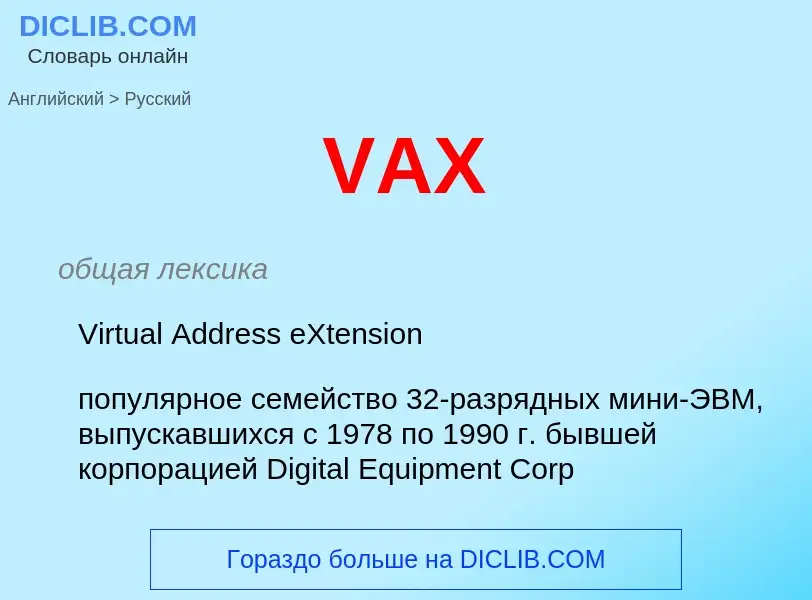Перевод и анализ слов искусственным интеллектом ChatGPT
На этой странице Вы можете получить подробный анализ слова или словосочетания, произведенный с помощью лучшей на сегодняшний день технологии искусственного интеллекта:
- как употребляется слово
- частота употребления
- используется оно чаще в устной или письменной речи
- варианты перевода слова
- примеры употребления (несколько фраз с переводом)
- этимология
VAX - перевод на русский
общая лексика
Virtual Address eXtension
популярное семейство 32-разрядных мини-ЭВМ, выпускавшихся с 1978 по 1990 г. бывшей корпорацией Digital Equipment Corp
сокращение
[variable-area record section] сейсмический разрез, записанный способом переменной ширины
Смотрите также
общая лексика
операционная система, разработанная корпорацией Digital Equipment для Alpha-серверов. Её первоначальное название VMS
Смотрите также
медицина
вакцина против жёлтой лихорадки
Википедия
VAX (an acronym for Virtual Address eXtension) is a series of computers featuring a 32-bit instruction set architecture (ISA) and virtual memory that was developed and sold by Digital Equipment Corporation (DEC) in the late 20th century. The VAX-11/780, introduced October 25, 1977, was the first of a range of popular and influential computers implementing the VAX ISA. The VAX family was a huge success for DEC – over 100 models were introduced over the lifetime of the design, with the last members arriving in the early 1990s. The VAX was succeeded by the DEC Alpha, which included several features from VAX machines to make porting from the VAX easier.
VAX was designed as a successor to the 16-bit PDP-11, one of the most successful minicomputers in history with approximately 600,000 examples sold. The system was designed to offer backward compatibility with the PDP-11 while extending the memory to a full 32-bit implementation and adding demand paged virtual memory. The name VAX refers to its Virtual Address eXtension concept that allowed programs to make use of this newly available memory while still being compatible with unmodified user mode PDP-11 code. The name "VAX-11", used on early models, was chosen to highlight this capability. The VAX ISA is considered a complex instruction set computer (CISC) design.
Later models in the series dropped the −11 branding as PDP-11 compatibility was no longer a major concern. The line expanded to both high-end machines like the VAX 9000 as well as to the workstation-scale systems like the VAXstation series. The VAX family ultimately contained ten distinct designs and over 100 individual models in total. All of these were compatible with each other and normally ran the VAX/VMS operating system.
VAX has been perceived as the quintessential CISC ISA, with its very large number of assembly language programmer-friendly addressing modes and machine instructions, highly orthogonal instruction set architecture, and instructions for complex operations such as queue insertion or deletion, number formatting, and polynomial evaluation.


.jpg?width=200)
![benchmarking]], showing internals benchmarking]], showing internals](https://commons.wikimedia.org/wiki/Special:FilePath/SPEC-1 VAX 05.jpg?width=200)

.jpg?width=200)
![A yellow fever vaccination certificate issued by the [[Soviet Union]]. A yellow fever vaccination certificate issued by the [[Soviet Union]].](https://commons.wikimedia.org/wiki/Special:FilePath/Soviet International Certificate of Vaccination or Revaccination Against Yello Fever.jpg?width=200)
